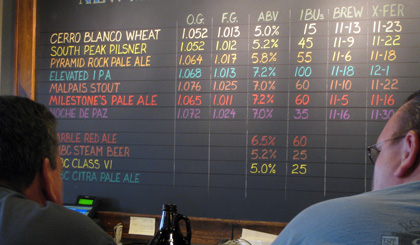
This is a “map cartouche of one of the Western Hemisphere’s earliest recorded recipes (for a form of beer).” It was taken from from America, a map by Jodocus Hondius (Amsterdam, 1606). Seems like a poster that would sell well in homebrew shops.
You’ll find it here, along with dozens of other images from the Clements Library at the University of Michigan, and more about the growing American culinary history collection at the library.
* Trading up to beer (and then to wine). A working paper from the American Association of Wine Economists exams the evolution of beer consumption between countries and over time. Parts are easier to understand if you have an Economics to English dictionary at your side.
Although the focus is on economics, the authors look at all the factors that determine what makes a “beer drinking nation.” In doing so, they track how consumption in those nations has changed dramatically in the past 50 years and ask why. Their findings, in economic speak:
Our first important result is that we do indeed find an inverted-U shaped relation between income and per capita beer consumption in all pooled OLS ánd fixed effects specifications. From the pooled OLS regressions (Table 3), we find that countries with higher levels of income initially consume more beer. Yet, the second order coefficient on income is negative, indicating that from a certain income level onwards, higher incomes lead to lower per capita beer consumption. The first and second order effects for income are strongly significant and the coefficients are quite robust across the different specifications.
The fixed effects regression results confirm this (Table 4), so the non-linear relationship for income holds not only between countries, but also within individual countries over time. As a country becomes richer, beer consumption rises, but when incomes continue to grow, beer consumption starts to decline at some income level. We calculated the turning point, i.e. the point where beer consumption starts declining with growing incomes, to be approximately 22,000 US dollars per capita.
So you get a graph that looks like this, with beer sales soaring in emerging economies — quite obviously China, but also Russia, Brazil and India.

What the wine economists want to know is “what’s next?” As consumers grow richer will they spend more money on wine (and less on beer)? The Chinese effect has already boosted prices of high-end French wines. Most predict something similar with wines across all prices categories, although that might be 20 years off.
What the study doesn’t consider at all is “beer different,” as in not a commodity, the beers drinkers are “trading up” to on a regular basis, in just about any country where they can find them.
* ‘Extreme’ boiling. Port Brewing/Lost Abbey has begun a “behind the scenes” video series, the first featuring how it makes Hot Rocks Lager. This is an Old World beer, certainly not “extreme.” But the process is a little out of the ordinary, and might just be what it looks like to make beer in Hell. Tomme Arthur calls it a “super boil,” and it is. Pay close attention beginning about 1:40 into the video.
